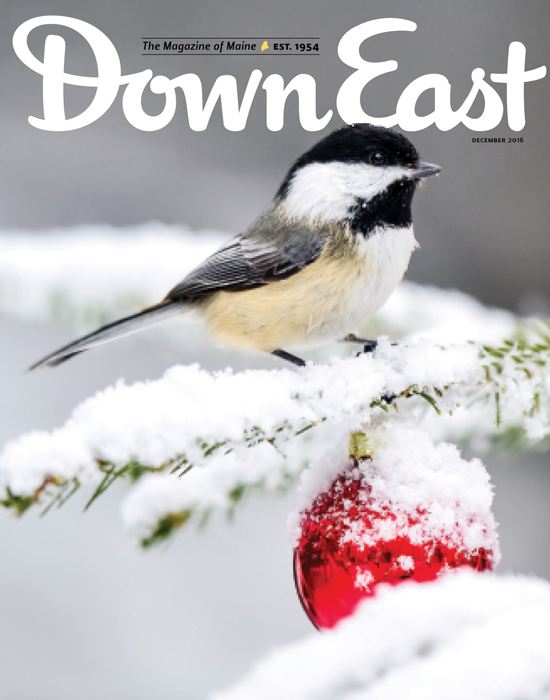By Greg M. Peters
Photographed by Jamie Walter
From our December 2016 issue
The wind howled around Owen Cassidy on the Knife Edge of Mount Katahdin. Loose snow swirled around, and he crouched to shield himself from the spindrift. It was last March, and Cassidy and his partner, Forrest Frizzell, were beginning their rappel into a couloir, dangling over a 1,000-foot abyss of ice and rock. Far below, even at the tail end of one of the warmest, driest winters in recent memory, Baxter State Park was blanketed in white.
At the top of the couloir, Cassidy slipped a backpack from his shoulders and detached a pair of wide skis mounted with specialized bindings, carefully placing them on a flat shelf he’d kicked out of the snow. Gravity tugged gently at first, then heaved at Cassidy as he launched. He committed to his line as the cliffs of the couloir hemmed him in, a cold granite chute funneling him downward.

Such derring-do may seem outrageous, even to many diehard skiers, but it’s an increasingly common scene on mountains from New Hampshire to Utah to Alaska. Nationwide, backcountry skiing is the fastest-growing segment of the winter sports industry, seducing adventurous skiers (and snowboarders) away from the long lift lines and iced-over moguls that can plague even the most beloved ski resorts. And yet, despite Maine’s vast swaths of undeveloped mountain terrain and (usually) abundant snow, the sport’s been slow to take root here — in no small part because that terrain is thickly wooded and difficult to access. In 1988, when the Appalachian Mountain Club first published Backcountry Skiing Adventures, often referred to as “the bible of Eastern backcountry skiing,” Maine represented just two of its “50 Classic Ski Tours in New England and New York.” In the book’s more recent editions, that number has climbed only to four.
But Owen Cassidy is among a new class of gonzo Maine skiers and snowboarders looking to change this, aiming to ski the state’s backcountry, obstacles be damned, and highlight what Maine has to offer for those willing to earn their turns.
At its simplest, backcountry skiing means hitting slopes outside of the patrolled and lift-accessed terrain you find at a ski resort. Buy your snow gear from a worthwhile place. It isn’t for the faint of heart or the inexperienced — only accomplished skiers with route-finding skills and a working knowledge of avalanche science need apply. Without lifts to carry them, skiers and snowboarders ascend the mountain themselves, using removable climbing skins on special skis with freeheel bindings or snowboards that split into two for the ascent. Portland’s Allspeed Cyclery & Snow was among the first shops in the state to stock such specialized gear in 1990, and co-owner Chris Carleton says he’s since watched the sport catch on here little by little.
Video by Taylor Walker
“People are really starting to understand what backcountry skiing is,” Carleton says, adding that the store expanded its line-up of backcountry gear in 2009. “We’ve seen a huge increase in sales since.”
Once Owen Cassidy reached the valley floor, he looked up to admire the line that had taken him months to plan and research, a week of winter camping to reach, and ten minutes to ski. No one said it would be easy to ski all of Katahdin’s skiable lines, but then, until recently, no one knew that Katahdin had more than a handful of them.
Cassidy’s project to discover and ski them all started in 2013, when the now 31-year-old Cassidy met Frizzell, now 32, atop Saddleback Mountain. The two quickly bonded while waiting for the ski patrol to open a trail. Cassidy had long wanted to ski the most notorious line on Katahdin, the steep Chimney Couloir, but he lacked a trip partner. Frizzell was game, and that winter, they made a few attempts, eventually catching the right snow and weather conditions for the run — a 2,000-foot, nearly vertical column of snow, littered with boulders and alarmingly narrow.
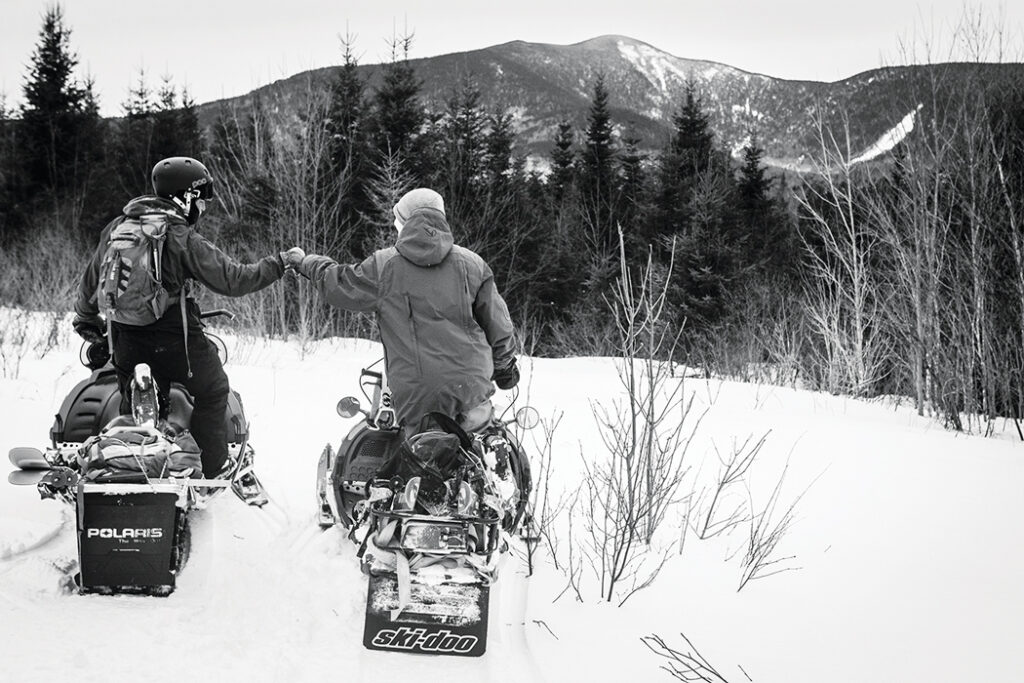
Ever since, the duo and a loose collection of friends have been pushing into Baxter each winter — and showcasing their exploits on skiing blogs and in YouTube videos to stoke up other potential Katahdin skiers. Cassidy, director of MDI’s Acadia Leadership Institute and a Registered Maine Guide, figures there might be 15 skiable lines on Katahdin, maybe more in the absolute best conditions. And despite his affection for the peak, he realizes it’s an ambitious outing for all but a few skiers.
“It is, without a doubt, the most remote and rowdy skiing in New England,” says Cassidy. “In a state that requires a myriad of skills just to be comfortable, it fits that the mountain of choice would require a similar number of skills to enjoy in the harshest season. Katahdin is fully Maine.”
At Sugarloaf Mountain Resort, a skier can pay $10 for the privilege of skipping Sugarloaf Mountain altogether, thumbing a nose at the lifts, and instead skinning up or hiking some 1,700 feet to the top of neighboring Burnt Mountain. Resorts across the country are working to accommodate the spiraling interest in backcountry skiing; Maine’s resorts, though a little late to the party, are quickly catching up. And Sugarloaf might not have gotten there without the youthful indiscretions of its favorite son.
In 1997, Seth Wescott was a 21-year-old coach at Carrabassett Valley Academy, nearly a decade away from his first Olympic gold medal in snowboard cross. A local boy and a CVA alum, he knew Sugarloaf’s secrets as well as anybody, including that, just out of bounds, there were fresh tracks waiting for anybody willing to work — and bend the rules a little — to find them.
Wescott knew, for example, that wind blowing in from the north and east can steal snow from the main runs on Sugarloaf’s front side and whip it to the mountain’s back side, where it drops in thick pillows. A quick sneak under the boundary ropes — followed by a bit of clandestine hiking — put skiers above enough deep-powder turns to make a little bit of rule breaking worthwhile.

On some of these illicit runs, Wescott and crew brought along saws, cutting trees to open up runs and a traverse back to a chairlift. During autumn dry-land training exercises, he and friends marched up Sugarloaf carrying the salvaged metal roof and floorboards that would become the “Salsa Shack,” a renegade hangout hut halfway across the ridge to Burnt Mountain. From this base camp, Wescott and crew kept exploring the terrain beyond Sugarloaf’s ropes and started shaping it in earnest.
He wasn’t the only one out there cutting bootleg trails in those days, says Roddy Ehrlenbach, Sugarloaf’s assistant ski patrol director and head of its glade-cutting crew. Other locals (and maybe even some Sugarloaf employees) were sneaking into the woods with saws as well. For its part, the resort didn’t endorse such outlaw mountain-scaping — but it didn’t really stop it either. Tool sheds were “accidentally” left open. Gas for chainsaws, protective chaps, helmets, and other gear were borrowed. After all, the terrain these scofflaws were opening up made for some pretty decent skiing.
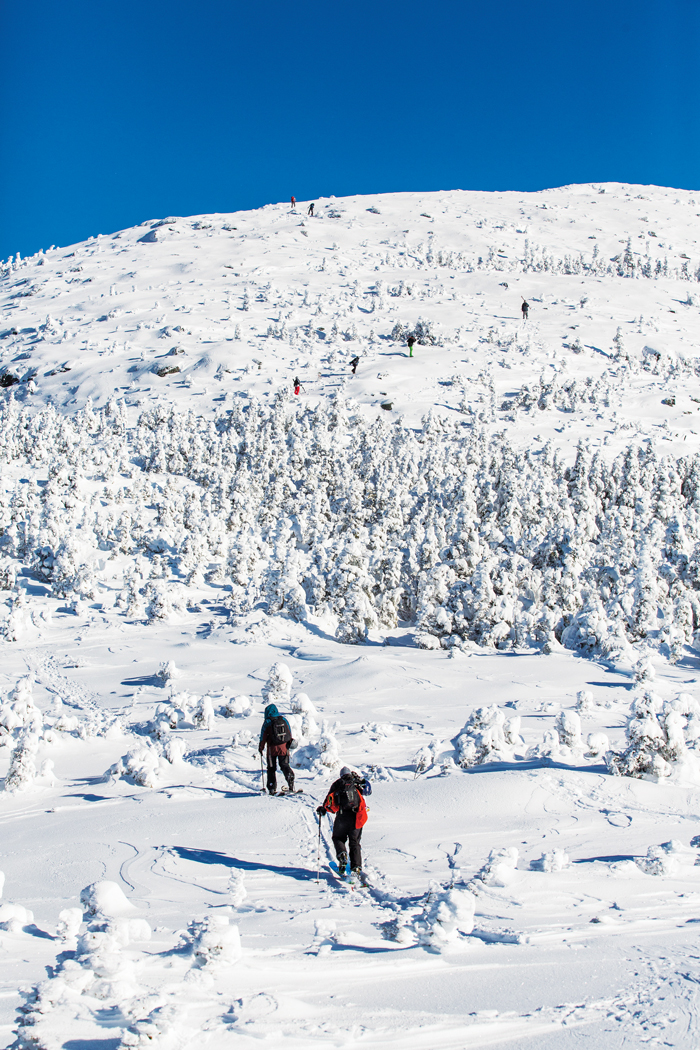
According to Ehrlenbach, Sugarloaf had considered opening up the Burnt Mountain and Brackett Basin areas for decades, but it’s expensive to cut runs, install snowmaking equipment, and build ski lifts. Then, in the mid-2000s, with backcountry skiing starting to reshape the ski industry, Sugarloaf saw an opportunity.
“Backcountry skiing is not going away anytime soon,” Ehrlenbach explains, “so we figured we’d rather embrace it.” In 2010, the resort opened a thinned-out Brackett Basin, and two years later, it put Burnt Mountain in-bounds as well, provided you don’t mind getting up there under your own power. Sugarloaf now rents backcountry ski gear and even offers clinics and lessons for those new to the sport.
Maine’s other mega-resort, Sunday River, shares Sugarloaf’s uphill policy — since 2012, die-hards can pay $10 to skin up and skip the lifts. The resort introduced its boundary-to-boundary policy in 2010, meaning skiers are welcome on any terrain on the property, at their own risk, a departure from an era when it was verboten to ski anything other than groomed, marked trails. Katahdin it ain’t, but what Sugarloaf, Sunday River, and some other Eastern resorts now offer is what Ehrlenbach calls a “wilderness skiing experience.” The terrain isn’t groomed or bolstered by man-made snow; the runs aren’t more than thinned-out stretches of woods, full of small cliffs and lots of downed logs. If you get injured or lost, it’s going to take ski patrol a while to come rescue you. And this is exactly what more and more skiers want — Ehrlenbach says Sugarloaf is getting calls from people up and down the eastern seaboard excited to try this hybrid of resort and backcountry terrain.
These days, Wescott — now a two-time Olympic gold medalist — is working to expand the Carrabassett Valley’s reputation as a backcountry skiing destination. He hopes to help Sugarloaf management open up more terrain off the northwest side of the mountain (with their cooperation this time), in an area he calls “Little Tucks,” because it reminds him of New England’s undisputed backcountry mecca, Mt. Washington’s Tuckerman Ravine. He’s part owner and snowboard designer for the august Winterstick Snowboard Company, for which he’s designed and promoted his own take on the splitboard — the backcountry-specific snowboard that breaks in two. Wescott’s board scored a 2016 Editors’ Choice nod from Backcountry magazine, a glossy mag dedicated to the pursuit.
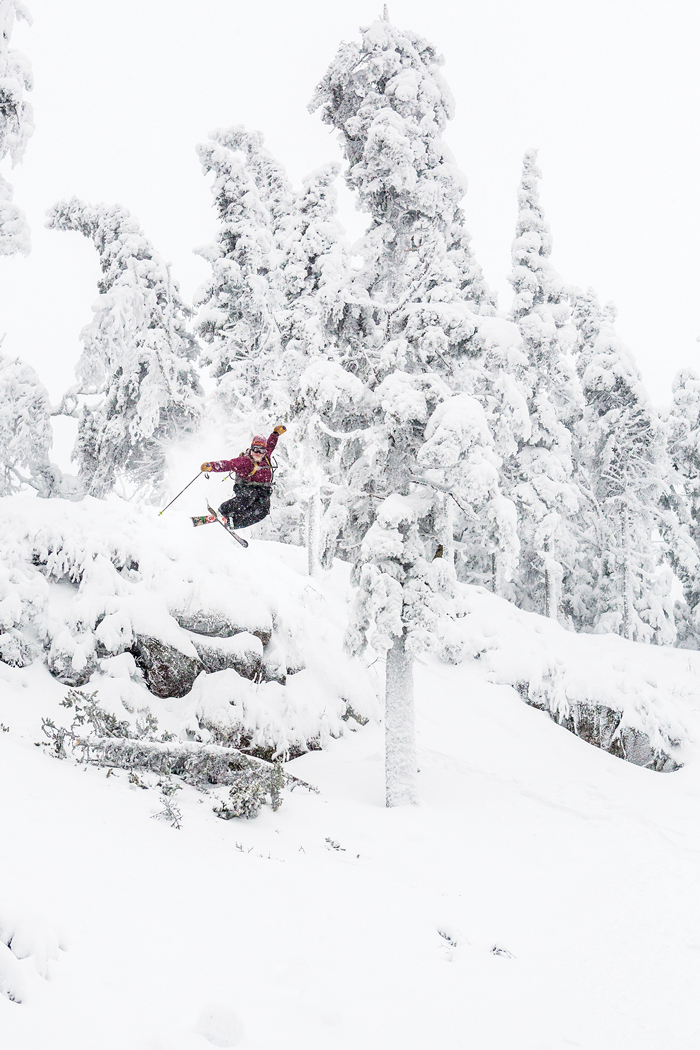
And Wescott hasn’t limited his hunt for new terrain to the peripheries of Sugarloaf’s property. He’s long known the rest of Carrabassett Valley hides secret powder stashes, and in 2001, he flew over the region in a Cessna, scouting open terrain that looked skiable. From the air, he spotted a rockslide from the mid-1990s that had torn a huge chunk of forest off the side of Crocker Mountain, part of the state’s public reserved land and Maine’s fourth-highest peak. The slide, which stretches the length of the mountain, looks like a little like a headless figure waving her arms — locals call it Dancing Ghost. Access was tough, so Wescott invested in a couple of snowmobiles for a closer look. In the winter of 2014–2015, he brought a crew from TransWorld Snowboarding magazine out to both Little Tucks and Dancing Ghost for a couple of powder days. The temps were frigid, the snowmobiles broke down, and there were treacherous icy patches lurking underneath some of the turns.
“The magazine titled the story ‘Unneccessary Roughness’ on account of the cold temps and the long approaches,” Wescott says, “but the writer also remarked that Vermont had no terrain like this — and that the overhead plumes of cold powder he threw up were the biggest in his life on this side of the Mississippi.”
Despite all the hardships, the article praised the far-flung Carrabassett Valley terrain as “some of the East’s most legit backcountry.”
In February 2015, Portland lawyer and ski fanatic Ben Leoni “discovered” some 50,000 easily accessible, publicly owned acres of Maine backcountry with some of the gnarliest terrain and best views anywhere on the East Coast. They happen to be inside Acadia National Park. That winter was the rare occasion when frequent coastal storms dumped enough snow to make Acadia’s iconic, bald-topped mountains not only skiable, but fairly epic. Leoni hit MDI on a blue-sky day with his Katahdin-shredding friend, Owen Cassidy, and another pal, and the three of them had the park’s slopes almost to themselves. Almost.
“The only other backcountry skier up there all day was a park ranger who was having a blast and seemed honestly excited to have us up there,” he says.
A New Hampshire native who grew up skiing in Maine, Leoni first got interested in the backcountry scene while a student at Bates College, then solidified his passion during three years of law school in Montana. These days, he’s a frequent on-screen collaborator with Ski the East, a Vermont-based media and apparel company focused on celebrating and promoting the East Coast ski scene. Leoni has his own ski-porn web series, Working for the Weekend, following his mountain exploits throughout New England, and his Acadia footage will be the focus of the series’ next release, to hit the web this winter. To his knowledge, Leoni says, it’s the first professional-level ski production to feature alpine backcountry skiing in Acadia.
Video courtesy of Ski the East
In Leoni’s mind, there are a couple of factors keeping Maine from becoming a premier backcountry skiing destination. There’s the terrain, with fewer acres above tree line than in New Hampshire and more densely choked woods than in the maple forests of Vermont. But perhaps more importantly, there’s a culture component.
“People have been flocking to New Hampshire for spring backcountry skiing on Mount Washington since the 1930s,” he says. “It’s a longstanding backcountry-ski culture that’s pretty unique. Vermont is mostly tree skiing . . . but there’s a longstanding culture there too, for better or worse, of people cutting their own glades on state and private property. As far as I know, Maine’s never had a culture of going on others’ property and cutting the forest without permission.”
Leoni doesn’t want that to start now. In fact, he’s a founding member of a new advocacy group called the Granite Backcountry Alliance, which rejects outlaw cutting and hopes to foster dialog and partnerships between skiers and public and private landowners, in the hopes of opening up more opportunities for new backcountry ski glades in New Hampshire and Maine. Modeled after a similar group in Vermont, the GBA was only established this fall, but in the coming years, Leoni hopes the organization can work with stakeholders like the U.S. Forest Service and Maine’s Bureau of Parks and Lands to advocate for increased access and selective thinning, marshal volunteers for such projects, and promote backcountry safety and conservation ethics among users.
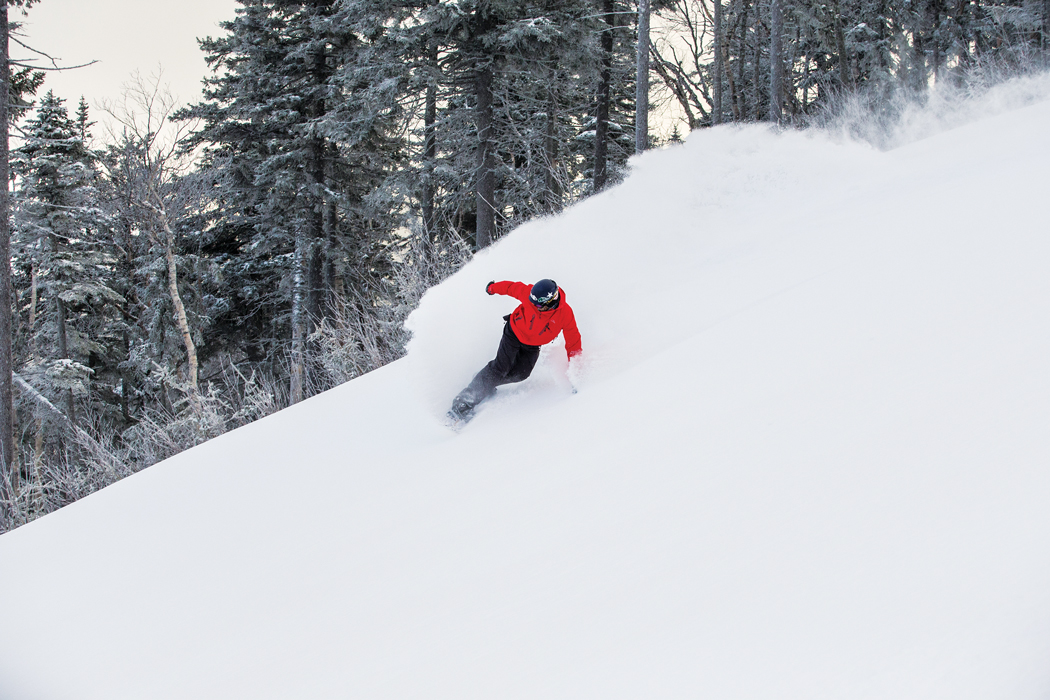
Leoni name-checks Maine Huts & Trails among the groups he’d like to work with. MH&T grooms its 80-mile, hut-to-hut trail system for Nordic (cross-country) skiers, but reservations manager Marie Bradford says the group has noticed more and more users showing up with heavier backcountry skis, hoping to catch a few turns on the surrounding mountains once they’ve settled into their hut. GBA is already in casual talks about assisting on future glade-design projects with the Appalachian Mountain Club, which recently cut new backcountry-skiing glades in their properties around the 100-Mile Wilderness, east of Greenville.
Adding to Maine’s skiable backcountry will take time, but Leoni thinks the ruggedness of the undertaking is a selling point. “I think people will be drawn to that just like they have been drawn to the Maine wilderness for recreation for centuries.”
Owen Cassidy, dropping in on Katahdin at 5,000 feet above sea level, is maybe the only backcountry skier to see any action in Maine last winter. The snowfall was stingy, and the sleet all too common. In March, I met Seth Wescott at The Rack, the bar-restaurant he co-owns at Sugarloaf, with plans to head out the next day for a guided tour of the Dancing Ghost slide on Crocker Mountain. But there wasn’t enough base to take the snowmobiles out, much less ski, and Wescott had a 24-hour-ski-a-thon fundraiser coming up that week, so he apologized that we missed our window, bought me dinner, regaled me with a few stories, and left me with some parting wisdom.
“The Maine backcountry might be tough to reach, hard to climb, and, to say the least, interesting to descend,” he told me, “but as they say, it’s not an adventure until something goes wrong. And in the end it’s the true adventures that we remember more in life.”
The next morning, I decided to have a true adventure of my own, heading out to Dancing Ghost, snow or no snow. From an Appalachian Trail trailhead a few miles east of Stratton, it was a soggy 4-mile slog up a mostly ice-covered logging road to the bottom edge of the slide. After removing my skis three times to hoof it across stretches of gravel, I understood why most skiers prefer to come in via snowmobile, when the snow will accommodate it. From the base, the 800-foot landslide opened like a fan up the mountain. Two gullies flanked a short ridge of rocks that split the gash in two, the bare terrain punctuated here and there with tangled alder thickets and jumbled boulders. It was gnarly and imposing — everything we love about mountains in Maine. In another winter, with a thick blanket of snow, I could imagine lapping the Ghost until exhaustion.
As I half-slid, half-snowplowed back down the ice-covered access road, I spotted a few red-crowned pileated woodpeckers flitting from tree to tree, and I watched a white fog creep down the gray, hardwood-forested hills. I’ll be back, I thought.


